I. Team Profile
3.1 Team Name
The name of our team, RedBytes, was influenced by our passion for technology and its advancements along with our mission to support the medical institutions of Vietnam. To be more specific, RedBytes was inspired by the Red Cross Organization combined with our team’s interest in data and information technology study. And aligning with our objective to help the medical industry, our team has begun the Loving Donor project, where we will be devoting our effort to create a website to encourage the blood donation movement in Vietnam. We have set our goal to make a digital page that will be the unifying front for all blood donation related activities of which will be dedicated for patients who are in need of blood transfusion, healthy blood donors and also professional medical practitioners. From our research, we understand that the practice of blood donating has only begun to rise in popularity in Vietnam in recent years, owing some parts to the infamous Covid-19 pandemic (Vietnam+ 2022). However, Vietnam has yet to achieve the ideal position where our people throughout the country have easy access to a safe and quality ensured blood transfusion system. Therefore, with this project, we hope to be able to make a difference in improving the health and safety of the public.
3.2 Personal Information
Tran Nguyen Quoc An - s3959931

An is a friendly person. He used to be specialized in math, perhaps that is why he has a logical mindset and works very methodically and clearly. An has not had much exposure to IT as he only has basic knowledge of HTML, CSS, and Python. However, it can be seen that he is constantly trying to learn and develop every day, and is increasingly falling in love with IT.
Pham Trong Nghia - s3974975

Nghia is a freshman at RMIT, with the desire to become a data engineer, Nghia always wished he could create a solid foundation for an AI, Besides being passionate about IT. Nghia is interested in two sports, badminton and soccer. Although he does not have much experience in programming or IT-related things, Nghia believes that he can easily absorb it when he is really passionate about it. Being more of a listener than a looker, Nghia believes that when working in a team, he himself will be a supporter instead of a leader or in other position
Dang Minh Triet - s4022878

Triet is a student who has recently transferred to RMIT, he has a background in media study and data analysis and is now working to complete his IT degree with a focus on machine learning and AI. Since moving back to Vietnam, he has been working hard on his personal-development journey, so aside from learning and practicing his technical skills in programming, he is striving to make overall improvement to his well-being. In the first half of 2023, Triet has managed to create a much healthier lifestyle that is built upon good habits, such as working out regularly, adopting the ‘eat clean’ diet, weekly journaling/book keeping and so on. He is also partaking in some online courses aside from university classes to gain more knowledge and expertise in AI research and development, this is part of his goals towards joining the IT industry.
Phuong Tran - s3979638

Phuong, also known as Maddie, is an undergraduate freshman at the College of SSET at RMIT University. Majoring in IT, she likes watching movies and hitting the gym in her free time. Her fascination for Artificial intelligence and the Internet of Things (IoT) grew proportionally with the growth of the Internet era, igniting a deep curiosity about the world of technology inside her. Further driven by her desire to create innovative solutions that enhance the quality of life, Phuong has gained experience developing a minor web project and a smart home setup through the power of AI and IoT. Phuong looks forward to further pursuing more expansive areas of IT as it advances at a breakneck pace while also keeping up with the latest AI models.
II. Tools
Our team has created a Github repository to store our project resources including pictures, reports, documents and the web application itslef. This process aims to simplify the creation and management of these items, ensuring they are easily accessible and organised effectively.
- Link to git repository
https://github.com/madietran/A3-Blood-Donation-Web-Project.git
- Guide to view our project prototype:
Step 1: Choose “Download Zip” to download the project repository and unzip the file

Step 2: Open the folder from an IDE of choice (eg. Visual Studio Code)
Step 3: To view the web prototype, open and run file “index.html”
(/A3-Blood-Donation-Web-Project/index.html)
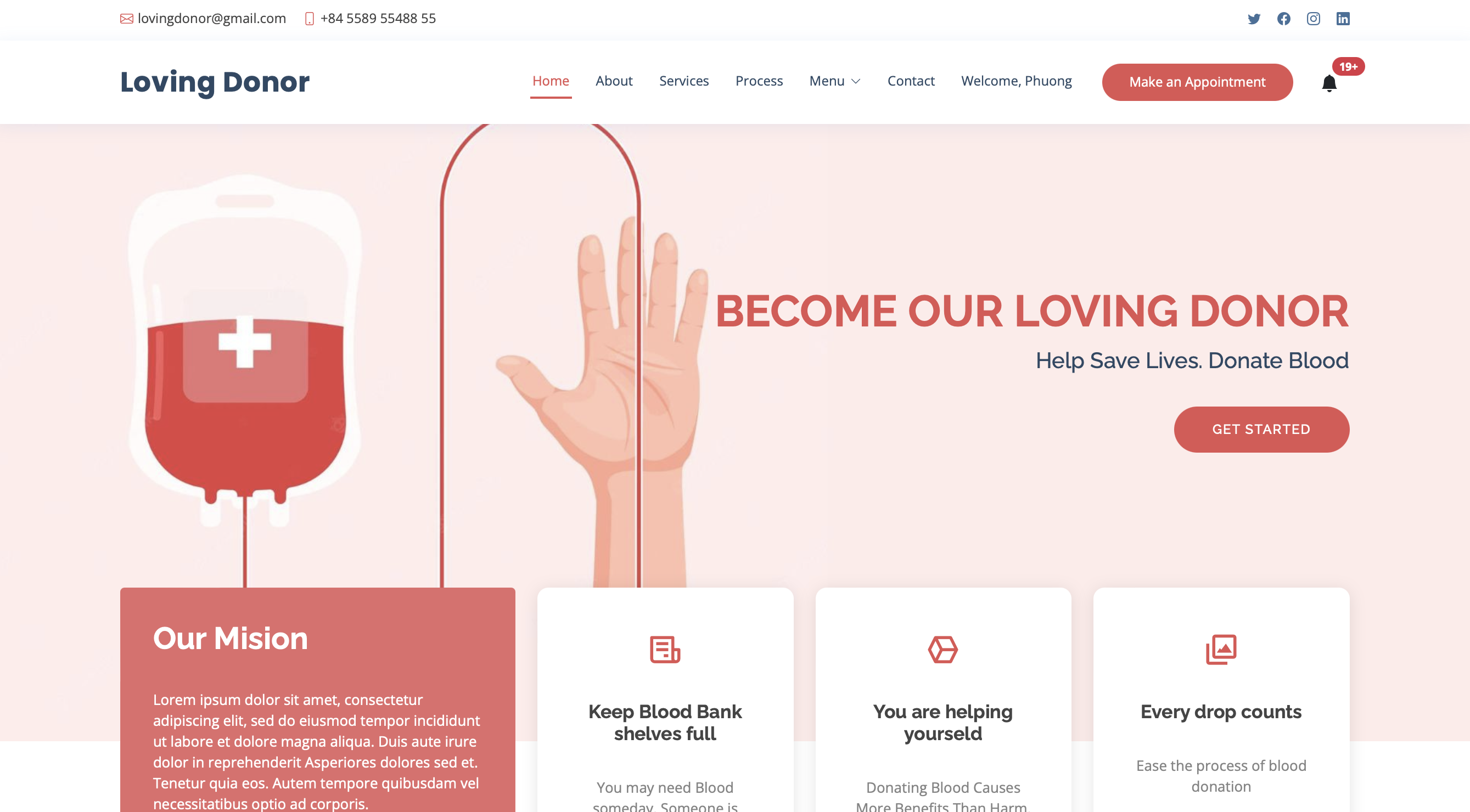
Step 4: To view the report, navigate to the folder named “Report” and open file “report.html” (/A3-Blood-Donation-Web-Project/Report/report.html)
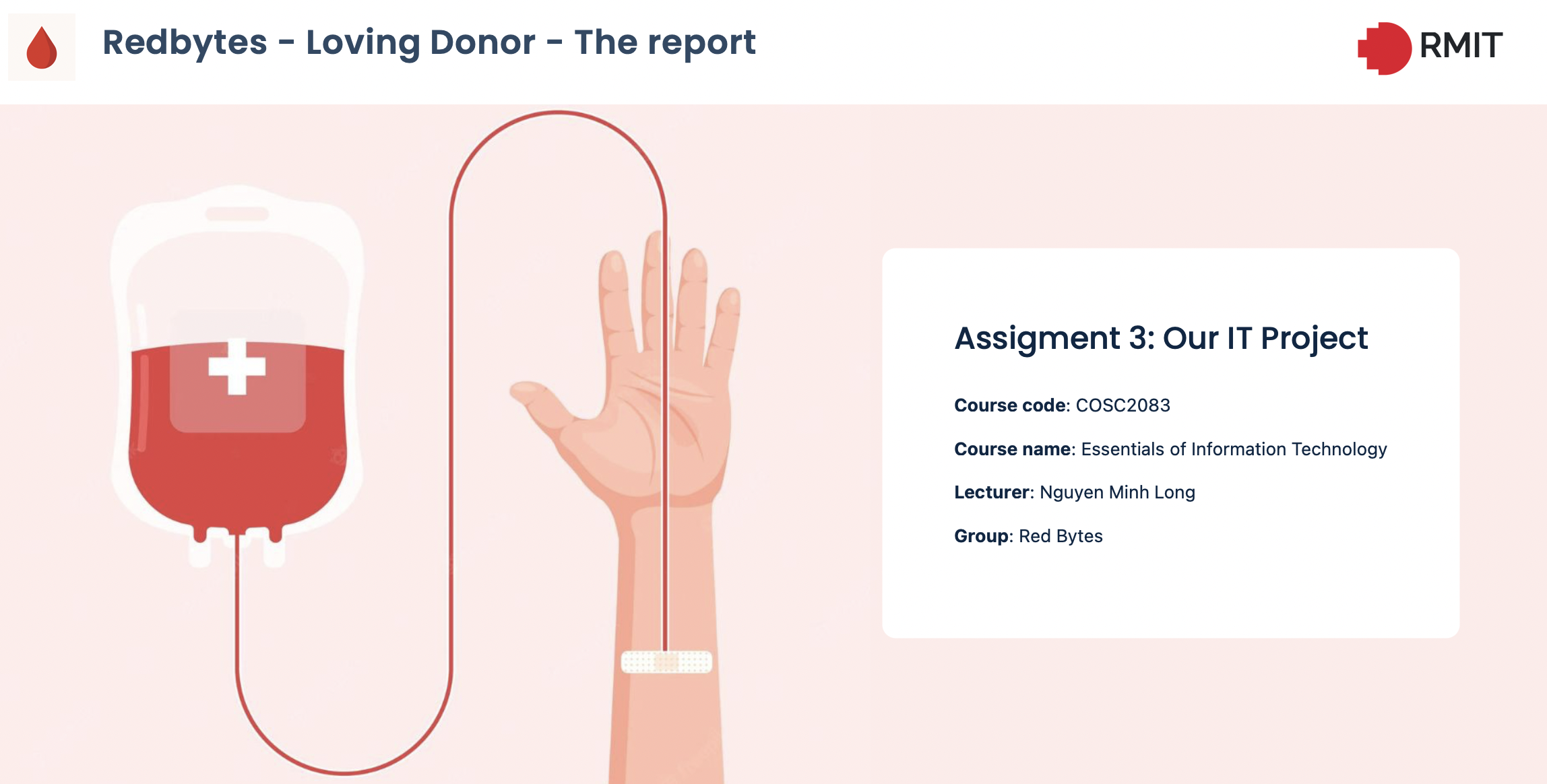
- Overall comment on the audit trail:
The audit trail on our Git repository effectively reflects our group's work throughout the project. As we review the commit history close to the time of submission, we can see that our team focused on committing changes mainly towards the end of the project. This approach of committing changes at the final stages indicates that team members diligently worked on their assigned tasks and waited for the completion of their respective portions before pushing to the repository. This strategy minimised the need for frequent editing of other commits, reducing the chances of conflicts and ensuring a smoother collaboration process. Each commit represents a significant milestone or completed feature, allowing us to track the progress of the project effectively. The commit messages associated with each commit also provide clear and concise information about the changes made. This helps in understanding the purpose and scope of each commit without having to go through extensive code reviews or discussions. Although we did not create new branches for individual tasks, our decision to work directly on the main branch was driven by the nature of our project and the division of tasks among team members. This approach reduced the complexity of merging and conflicts, as each team member had distinct responsibilities and worked on separate components. Moreover, it prioritised timely completion of tasks and facilitated a streamlined and cohesive development process.
III. Project Description
3.1 Overview
3.1.2 Topic
Our project, Loving Donors, is an interactive and user-friendly blood donation website. It aims to connect hospital-based organisations and potential blood donors, emphasising the importance of blood donation and its benefits.
The website's home page provides comprehensive information about the donation process, eligibility requirements, and health considerations. It simplifies the registration process with an easy-to-use form, allowing donors to input personal information and update it as needed.
Key features of the website include blood donation scheduling, enabling donors to book appointments online and manage them flexibly. It also helps donors find the nearest donation facility based on their location. After each donation, the website assesses the donor's health and provides examination results for monitoring purposes. This helps hospitals manage their blood supply efficiently and plan future campaigns. Donors can track their donation history and milestones, fostering engagement.
Data analysis features to collect and analyse demographic and donation information, helping hospitals assess campaign efficiency and manage blood sources effectively. The website integrates with social media, sharing inspiring donor stories to encourage visitors. Contact information and support features are provided for donor inquiries.
Overall, our project aims to promote blood donation, raise awareness, and provide a user-friendly platform for donors. By optimising the donation process and utilising data analysis, we aim to increase donation rates, optimise blood resources, and save lives.
3.1.2 Motivation
The motivation behind our group's website project is based on the desire of its members to create positive value for the community, along wintributing their own blood donation experience to build the website. The "Loving Donors" project is an interactive blood donation website aimed at connecting potential blood donors with hospitals and organisations. Our website will focus on three main goals: optimising the blood donation process, personalising the user interface, and analysing data on the number of blood donors to control the blood supply in each area. Additionally, we include certain contemporary IT trends in our solution, such as predictive analysis based on statistical and machine learning models. Reviewing from our previous report submission for "The IT World", instead of using Excel for data analysis, our team will be adopting RStudio to carry out the necessary steps of data transformation, visualisation, and analysis. Through integrating the R analysis programming language, with the proper set up, we will be able to automate the analysis and visualisation processes for the website. Regarding the location function, we will use web-based mapping services such as Google Maps directly on the website with built-in databases and distance calculation. The service allows users to enter their current location and find the nearest blood bank. Finally, we believe that this website will be a useful tool not only in increasing convenience for blood donors but also in helping hospitals effectively manage their blood supply. Creating a website can showcase a wide range of skills such as web development, user experience design, problem-solving, project management, data analysis, reporting, and collaboration. It also highlights important soft skills like teamwork, creativity, innovation, and a dedication to making a positive social impact. With all these skills on display, our team is confident that the website will be an attractive candidate to employers.
3.1.3 Landscape
After deciding to make a website about blood donation, we found that we would face a lot of strong opponents like NHS Blood Donation - United Kingdom (https://www.blood.co.uk/), South African National Blood Service(https://sanbs.org.za/) and New Zealand Blood Service (https://www.nzblood.co.nz/). The NHS Blood Donation website, operated by the National Health Service of the UK, serves as the official platform for blood donation information, eligibility requirements, and the donation process. Similarly, the South African National Blood Service website and the New Zealand Blood Service website offer comparable resources, including appointment scheduling and information about blood drives. These websites aim to connect potential donors and facilitate the donation process by providing comprehensive information and convenient appointment booking. After analysing the competitor's strengths, we believe these will be the 3 strengths of the website: optimising the blood donation process, personalising the user interface, and analysing data on the number of blood donors to control the blood supply in each area. Our primary focus is streamlining the registration process for blood donation. We are implementing an intuitive form that allows donors to easily enter and update their personal information, aiming to optimise the overall blood donation process. In terms of user interface personalization, we will emphasise user interaction and friendliness to provide the optimal experience when registering, booking appointments and tracking their donation history. Last but not least, what sets our team's project apart from others in the market is the incorporation of data analytics features. This addition allows them to analyse and leverage data effectively, giving us a competitive edge. This data is valuable for evaluating hospital campaign effectiveness to identify trends and manage blood resources more effectively.
3.2 Detailed description
3.2.1 Aim
For this project, our team hopes to be able to contribute to the medical scene by creating a website that will unify the blood donating processes of all blood banks to become the ultimate all-access tools for patients, blood donors and medical practitioners.
In recent decades, Vietnam has made a great deal of efforts in its medical advancements, and especially with the voluntary blood donation movement, there has been significant development for the awareness of blood donating practice within our community. One report stated that the current population of our country would require an estimation of 2 million blood units to help relieve emergency situations (Vietnam+ 2022). However, the process of storing and preserving donated blood can be quite difficult without the proper equipment and facilities, especially for our country which is currently plagued with obsolete and insufficient medical machinery (International Trade Admission 2023).
Therefore, with this project, we want to streamline the process of blood donation and introduce the data analysis processes to help manage blood storage and transfusions amongst the many blood banks across Vietnam. To accomplish this mission, we have defined two major functions that will be the main focus of this project, the first of which is to develop a website that will be the front page of all blood donation practice in Vietnam and the second is to revolutionise the blood bank system through the application of data study to predict patterns and improve efficiency.
Regarding our first objective to attain the position of the premier website for blood donation, our team wants to create a website that beholds our users, and in this case - donors, as the centrepiece of our design. Our first step was to begin the market research, where the team looked into the user behaviour pattern and design philosophy of already existing websites which facilitate the blood donation services, and our team was able to identify one problem with these websites is that their overall quality and available services vary significantly, which creates an inconsistency that may confuse users, especially for first time donors, this disparity is also present in the blood banks’ databases where the majority of them would acts independently from one another. Which leads to our second objective, where we seek to consolidate all information for ease of access, especially in the case of emergency situations, and data study for insights on the most current and relevant trends of blood donation activities.
To achieve these two goals, our team has set up smaller and simpler steps to make the project more achievable, even with a small team like ours. First and foremost, a major emphasis is put on the research and planning phase as it would be a wise decision for us to learn as much as we can about the relevant topics that can help us create a better website and also to learn more about the blood donation business model. We must be able to recognize the need and want of blood donors in Vietnam and also how we can accommodate hospitals and blood banks, of which will be the stakeholders of our project. Careful planning is an important step for us to break down our work into digestible work artefacts to be completed within reasonable deadlines, this is to ensure the quality and timeliness of the team. And to integrate the data analysis module to the website, our team would require formal training and education to understand how we can make sense of the data collected from our stakeholders system to produce valuable comprehension to help improve their medical procedures.
3.2.2 Plan and progress
Phase 1: Market research and ideas initiation
Our research has revealed two primary concerns within the current Vietnamese blood donation market. The first issue is the presence of outdated and inconsistent designs among the websites hosting blood donation services. The design philosophies of these platforms vary significantly, leading to confusion among users, particularly first-time donors. The lack of uniformity in design can hinder user experience and discourage potential donors.
The second issue we identified is the existence of disconnected medical databases. In many cases, hospitals and blood banks operate independently from each other, including their storage logistics and databases. This lack of integration can result in inefficiencies, especially when it comes to analysis and research related to blood donations. Moreover, it can be detrimental in emergency situations where quick access to accurate and comprehensive information is crucial.
Then the seed was planted and Loving Donor was born. We embarked on a journey to create a user-friendly platform that would streamline the blood donation process and revolutionise the way donors and recipients connect. Our main objectives were to simplify registration, provide easy appointment booking, and ensure efficient management of donor data. Additionally, we aimed to leverage data analysis for better blood supply management and integrate social media to share inspiring stories and provide support to donors.
Phase 2: Development and brainstorming
As a team, we brainstormed ideas, refining and mapping out the key features and functionalities of the website. We carefully designed the user journey, focusing on creating a seamless and intuitive experience for potential donors. Our aim was to make the registration process simple and efficient, allowing users to easily book appointments and access personalised health assessments.
While progressing through this phase, we encountered various challenges and made important decisions to refine our project plan. We acknowledged the need to prioritise certain features to ensure feasibility and timely delivery. As a result, we made the decision to temporarily set aside more complex aspects, such as data analysis, to be addressed in future iterations of the website.
Finally, we came up with the detailed key features of our website, whose visual design must be developed first so the project prototype is easy to understand and accessible to potential stakeholders:
- Social media and news integration: Sharing stories of real-life heroes and providing a platform for support and inquiries will foster a sense of community and encourage participation in blood donation campaigns.
- Information and Education: The website provides comprehensive information about the donation process, eligibility requirements, and health considerations.
- Registration and Profile Management: Donors can easily register and update their personal information using an intuitive form.
- Blood Donation Scheduling: Donors can book appointments online and manage them flexibly.
- Location-Based Facility Finder: The website helps donors find the nearest donation facility based on their location. If their laptop does not have GPS, they can type their location in the search engine manually or Google map will use the IP address to detect the location (although the result might be inaccurate because user can change their IP address)
- Health Assessment and Monitoring: After each donation, the website assesses the donor's health and provides examination results for monitoring purposes. ChartJS will be used to visualise the data on the website.
- Donation History and Milestones: Donors can track their donation history and milestones, promoting engagement and involvement.
- Data Analysis: The website collects and analyses demographic and donation information to help hospitals assess campaign efficiency and manage blood sources effectively.
- Support and Contact Information: Contact information and support features are provided for donor inquiries.
- FAQ: frequently ask questions to give users information conveniently
Phase 3: Planning and actual progress
As we progress, we recognize the importance of thorough documentation and ensuring a seamless handover of the project to any future team members who may join. We strive to maintain detailed records of our progress, decisions made, and changes implemented to facilitate a smooth transition and continuity of the project.
- Planning
Week |
Person and task |
|||
|
An |
Triet |
Phuong |
Nghia |
|
|
Week 1 |
Create Drive:
Delegate tasks Support Phuong in designing the website |
Start writing Team profile Provide solutions Learn about HTML |
Create Git Repository Designing the website |
Learn about HTML make outlines for presentation |
|
Week 2 |
Outline for ERD Code the website feature |
Write an outline of the report |
Code the website feature |
Outline of scope and limit |
|
Everyone: Giving opinions on web development related to cloud hosting and data analysis Try data visualisation Note about team limitations |
||||
|
Week 3 |
Finalise the website code Write Overview, Group processes, and communications Plan the outline for presentation |
Write Team Profile, Aims, Roles, Timeframe, Group processes, and communications Code the HTML version of report |
Finalise the website code Write Tool, Plans and Process, Tools and Technologies, Risks Code the HTML version of report |
Write Scope and Limits, Timeframe, Testing Finish design of presentation Code the HTML version of report |
|
Everyone: Complete the demo of the website, run the necessary tests to avoid bugs Scripting the presentation, and rehearsing the presentation |
||||
|
Week 4 |
Everyone: Finalise web application, report and the html version of report Complete the presentation Complete Group reflection Submit assignment |
|||
- Actual Progress
Project Database:
Entity - relationship Diagram:

|
Relation Schema: The primary key and foreign key are displayed individually in the text, with the primary key being red and the foreign key being blue. |
|
|
Donor (address, blood_group, contact_number, name, sex, Id) Medical Report (mr_record, mr_date, Donor.Id, Employee.e_Id) Qualified Donor (Donor.Id) Not Qualified Donor (Donor.Id) Donate (d_quantity, d_date, Donor.Id, BloodDonationStation.bds_Id) Manager (m_name, m_Id, BloodDonationStation.bds_Id) Employee (e_name, e_Id, BloodDonationStation.bds_Id) BloodStorage (bs_quantity, bs_bloodgroup, bs_Id, BloodDonationStation.bds_Id) BloodDonationStation (bds_address, bds_contact_number, bds_Id) |
|
|
Database Creation: |
|
|
DROP TABLE IF EXISTS NotQualifiedDonor; DROP TABLE IF EXISTS QualifiedDonor; DROP TABLE IF EXISTS Donate; DROP TABLE IF EXISTS Medica lReport; DROP TABLE IF EXISTS BloodStorage; DROP TABLE IF EXISTS Manager; DROP TABLE IF EXISTS Employee; DROP TABLE IF EXISTS BloodDonationStation; DROP TABLE IF EXISTS Donor; -- Create the Donor table CREATE TABLE Donor ( Id INT PRIMARY KEY, address VARCHAR(255), blood_group VARCHAR(10), contact_number VARCHAR(20), name VARCHAR(100), sex VARCHAR(10) ); -- Create the BloodDonationStation table CREATE TABLE BloodDonationStation ( bds_address VARCHAR(255), bds_contact_number VARCHAR(20), bds_Id INT PRIMARY KEY ); -- Create the Employee table CREATE TABLE Employee ( e_name VARCHAR(100), e_Id INT PRIMARY KEY, BloodDonationStation_Id INT, FOREIGN KEY (BloodDonationStation_Id) REFERENCES BloodDonationStation(bds_Id) ); -- Create the Medical report table CREATE TABLE MedicalReport ( mr_record VARCHAR(10), mr_date DATE, Donor_Id INT, Employee_Id INT, PRIMARY KEY (mr_date, Donor_Id, Employee_Id), FOREIGN KEY (Donor_Id) REFERENCES Donor(Id), FOREIGN KEY (Employee_Id) REFERENCES Employee(e_Id) ); |
-- Create the Qualified Donor table CREATE TABLE QualifiedDonor ( Donor_Id INT PRIMARY KEY, FOREIGN KEY (Donor_Id) REFERENCES Donor(Id) ); -- Create the Not Qualified Donor table CREATE TABLE NotQualifiedDonor ( Donor_Id INT PRIMARY KEY, FOREIGN KEY (Donor_Id) REFERENCES Donor(Id) ); -- Create the Donate table CREATE TABLE Donate ( d_quantity INT, d_date DATE, Donor_Id INT, BloodDonationStation_Id INT, PRIMARY KEY (d_date, Donor_Id, BloodDonationStation_Id), FOREIGN KEY (Donor_Id) REFERENCES Donor(Id), FOREIGN KEY (BloodDonationStation_Id) REFERENCES BloodDonationStation(bds_Id) ); -- Create the Manager table CREATE TABLE Manager ( m_name VARCHAR(100), m_Id INT PRIMARY KEY, BloodDonationStation_Id INT, FOREIGN KEY (BloodDonationStation_Id) REFERENCES BloodDonationStation(bds_Id) ); -- Create the Blood Storage table CREATE TABLE BloodStorage ( bs_quantity INT, bs_bloodgroup VARCHAR(10), bs_Id INT PRIMARY KEY, BloodDonationStation_Id INT, FOREIGN KEY (BloodDonationStation_Id) REFERENCES BloodDonationStation(bds_Id) ); |
Feature design:
|
Authentication |
|

|

|
|
Landing page/ Home page |
|
< 
|

|

|

|

|

|
|
My Profile |
|
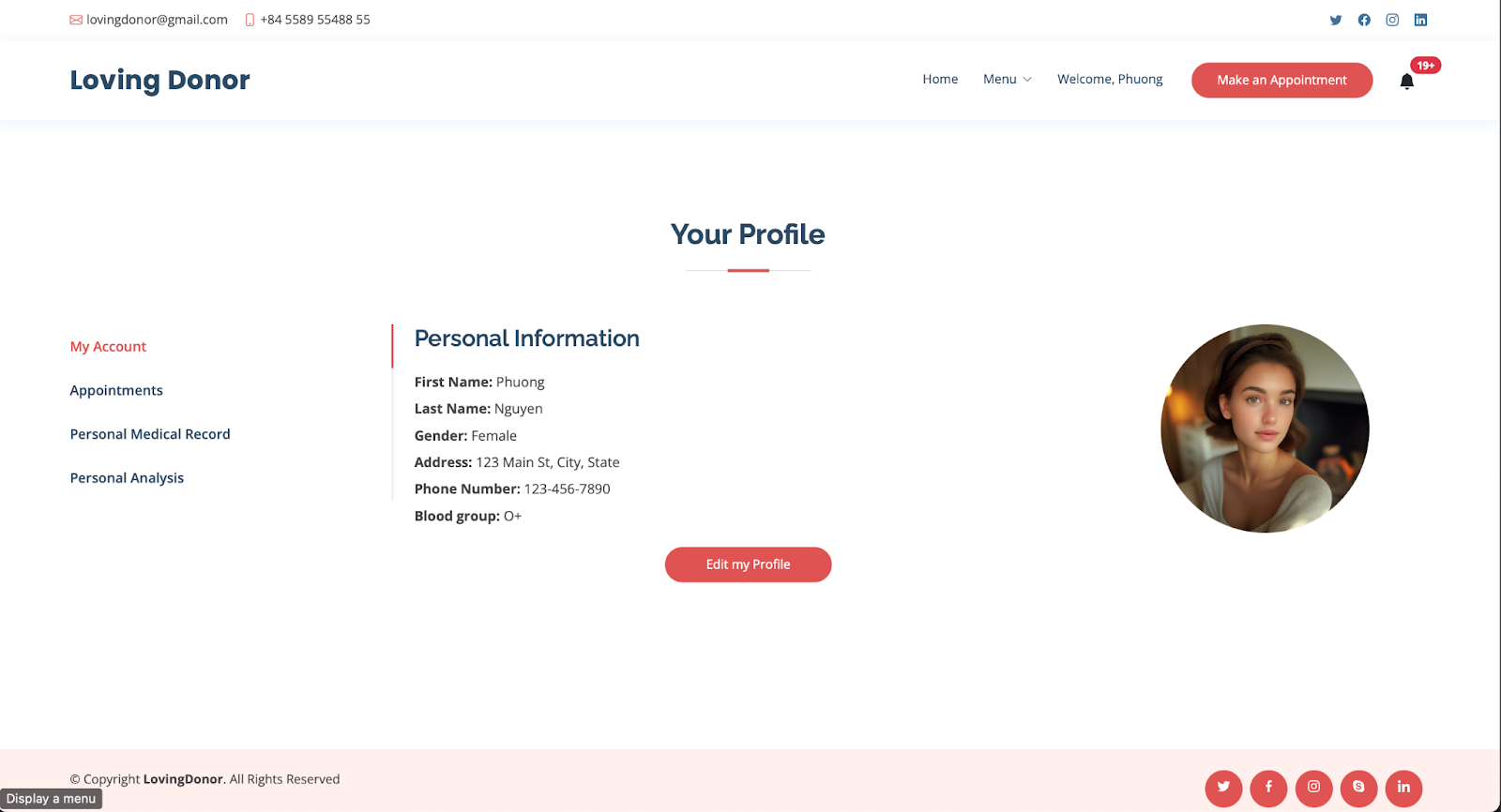
|
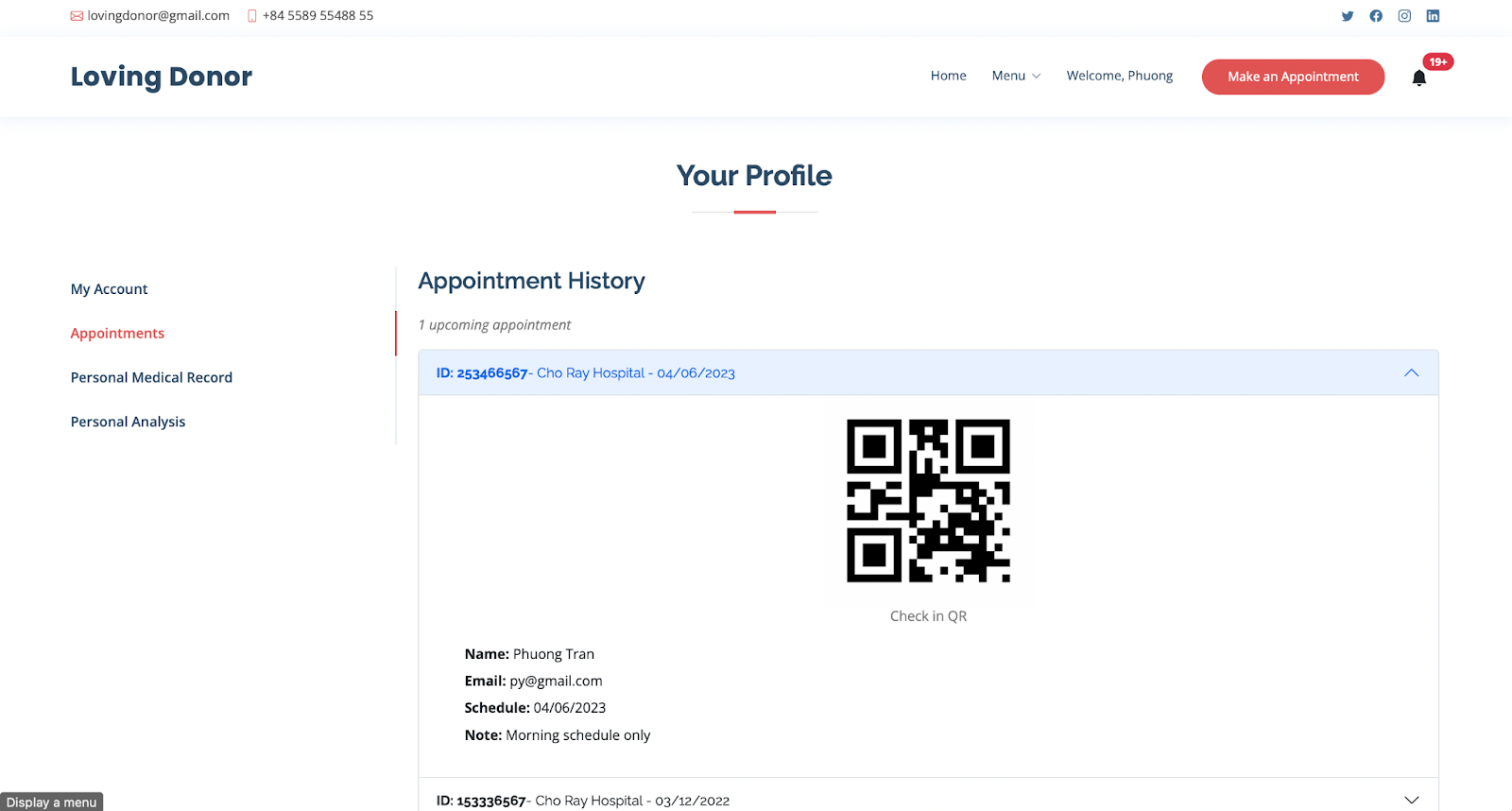
|
|
Medical Record |
|

|

|
|
Make Appointment |
|

|
|
|
Nearby stations |
|

|
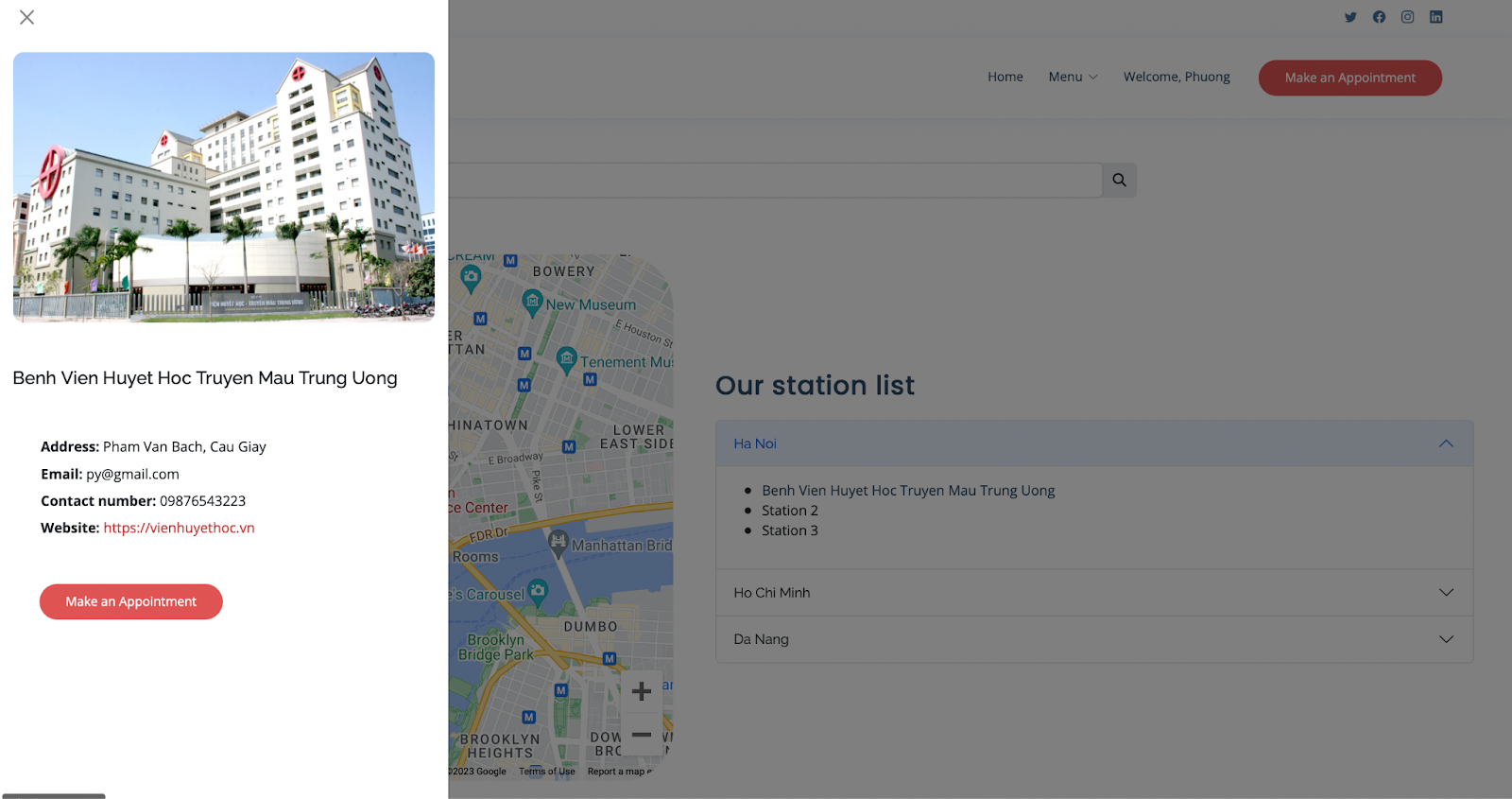
|
3.2.3 Roles
Over the first 4 weeks of working on the Loving Donors project, our team has been managing the research, planning, designing, and prototyping stages of the blood donation website. To accommodate these objectives, each team member has taken up work roles that are suitable for their respective set of skills to begin our work on the website.
-
An - Project Manager & Developer
An is responsible for overseeing our work as the team leader for RedBytes. He is also involved in building the website, taking on the roles of project manager and developer.
-
Nghia - Designer & Developer
Nghia works on both the design and programming aspects of the project. He is responsible for the website's design and project planning.
-
Phuong - Designer & Engineering Manager
Phuong serves as the lead coder for the project and manages the work of An and Nghia. Additionally, she handles the design of our website interface, hence the role of engineering manager and designer.
-
Triet - Business Analyst & Data Analyst
Triet conducts research on the current market for our website, reporting on its state, needs, and wants. He is also responsible for designing the data analysis module due to his background in data study.
Please note that these roles are subject to change as previous responsibilities are completed and new objectives emerge. We will make appropriate adjustments to the team's composition to better fit the later stages of development.
3.2.4 Scope and Limits
|
Feature for Loving Donor project |
|||
|
Scope |
Feature |
Description |
Priority |
|
In scope: |
Basic website features |
|
High |
|
User’s account signup & login. |
|
High |
|
|
Appointment manage |
|
High |
|
|
Notifications |
|
Medium |
|
|
Donor Feedback and Analysis |
|
Medium |
|
|
Google Maps and GPS |
|
Medium |
|
|
News and Updates |
|
Low |
|
|
Out scope: |
Community Forum |
|
|
Table 1: Feature of Loving Donor project.
Our limitations on the project are summed up in the following points:
- Firstly: there is no API integration, which leads to the slow processing of large data, updating information will be almost impossible to complete, and lacks the interactivity and compatibility of a website.
- Second: the website has no official server. Without a server for the website, there will be a lack of cloud management as well as not being able to publish the project to everyone, it will only be in the demonstration as well as the report.
- Last but not least: we lack the back-ends to support the site. This can cause the data appearing on the front end to be erroneous, affecting many related processes as well as the user experience.
In the future, we will find a way to fix as well as develop with the aim of making this project a reality to develop and even revolutionise blood donation. Besides, there are some features that are listed in the scope that have not been completed due to the lack of skills of the team.
3.2.5 Tools and Technologies
Over the first 4 weeks of working on the Loving Donors project, our team has been managing the research, planning, designing and prototyping stages of the blood donation website. To accommodate these objectives, each team member has taken up work roles that are suitable to their respective set of skills, to begin our work on the website. Currently in our team, we have An as the project manager and developer, Nghia as the designer and developer, Phuong as the designer and engineer manager, and Triet as the business analyst and data analyst. An acted as the team leader for RedBytes, thus, he is responsible for overseeing our work while also working on building the website which is why he has received the roles mentioned above. While Nghia is also responsible for the project’s programming aspect, he worked on the design of the website and project planning, hence the reason that he is named as both the designer developer. As the current lead coder for this project, Phuong managed both the work of An and Nghia while handling the design of our website interface, therefore she was dubbed as our engineering manager and designer. Triet is assigned the business analyst and data analyst position as he was tasked with researching the current market for our website to report on its current state, needs and wants; he volunteered for the module design for the data analysis function of our project because of his background in data study. It should be noted that the roles defined for our team in this section are not fixed in the long run, as previous responsibilities are completed and a new objective appears, we will make the appropriate adjustment to the team’s composition to better fit the later stages of development.
3.2.6 Testing
With our project, providing blood management web for hospitals, the test will involve the basics of the website including:
- User interface and experience: we need to make sure it's simple and easy to understand for the users, especially doctors or patients, and make sure there are no unexpected errors to provide the best UI/UX. In addition, we must ensure that our website can work smoothly in different browsers.
- Page loading speed: this is essential, our website must be stable when problems occur such as running out of blood in stock or a large number of users accessing at a time.
- Function: ensure that the update or user registration information is always accurate, especially blood groups to avoid unwanted situations.
- User experience: We also consult with friends through the experience of the website, thereby guessing the general preferences and habits of most users.
However, in the future, if RedBytes wants to be cross-platform compatible or roll it out globally, the team will need to check things related to language or compatibility. We should also learn more from other websites for reference purposes.
3.2.7 Timeframe
-
The table below shows the group's progress and tasks for the first 4 weeks:
Week
Person and mission
An
Triet
Phuong
Nghia
Week 1
Create Drive:
- Find resources
- Presentation file
Delegate tasks
Support Phuong in designing the website
Start writing Team profile
Provide solutions
Learn about HTML
Create Git
In charge of the front-end
Learn about HTML
make outlines for presentation
Week 2
Outline for ERD
Code the website feature
Write an outline of the report
Code the website feature
Outline of scope and limit
Everyone:
Giving opinions on web development related to cloud hosting and data analysis
Try data visualisation
Note about team limitations
Week 3
Finalise the website code
Write Tool, Overview, Group processes, and communications
Plan the outline for presentation
Write Team Profile, Aims, Roles, Timeframe, Group processes, and communications
Code the HTML version of report
Write Tool, Plans and Process, Tools and Technologies, Risks
Code the HTML version of report
Write Scope and Limits, Timeframe, Testing
Finish design of presentation
Code the HTML version of report
Everyone:
Complete the demo of the website, run the necessary tests to avoid bugs
Scripting the presentation, and rehearsing the presentation
Week 4
Everyone:
Finalise web application, report and the html version of report
Complete the presentation
Complete Group reflection
Submit assignment
Table 2: Group progress and task allocation during the first four weeks.
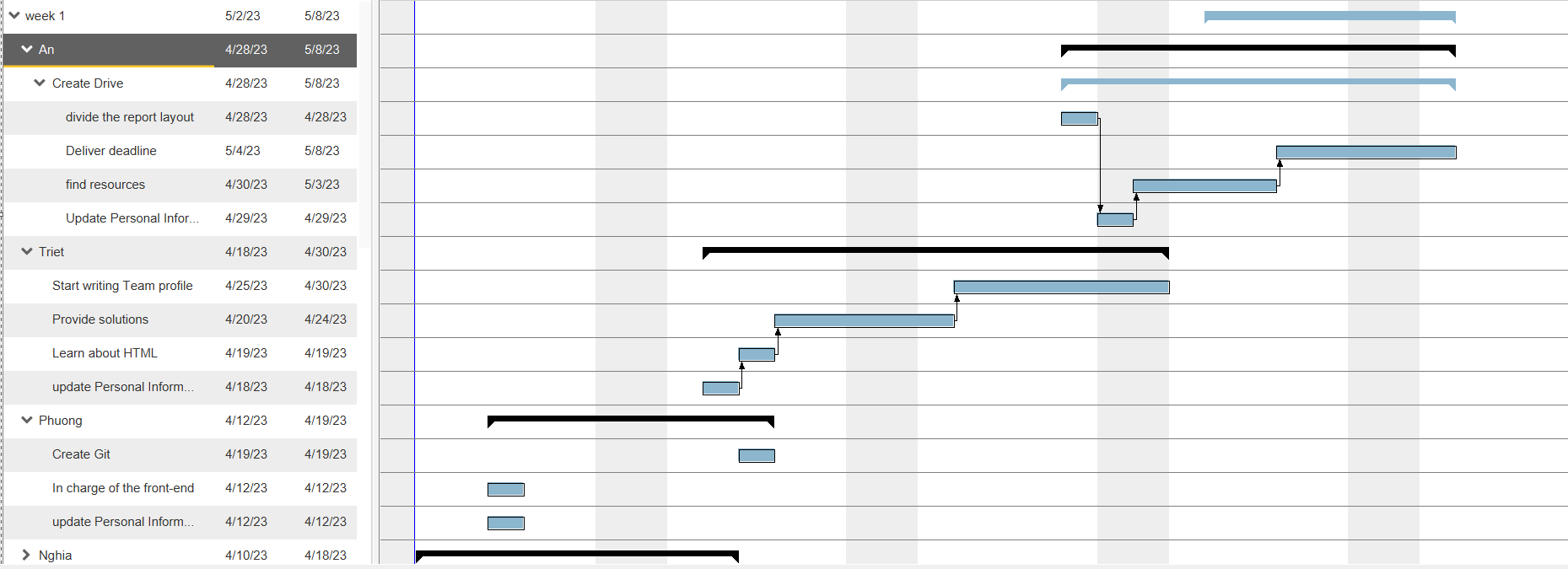
Next 12 weeks will be the prediction of the RedBytes team, we plan to hire more people for the positions, however since we do not know the number of each position, we have recorded the role instead of the name and the task prediction. as well as progress at the ideal level set by the team. The group also agreed to divide 12 weeks into 4 parts, with each part being 3 weeks along with the specific topics of each part.
Here is a table showing the next 12 weeks:
|
Part 1: Complete Website Loving Donor |
||||
|
Week |
Role and Tasks |
|||
|
Week 5 |
Graphics Design:
|
|||
|
Back-end Developer:
|
||||
|
Cyber Security Specialist:
|
||||
|
System Administrator:
|
||||
|
Week 6 |
Graphics Design:
|
|||
|
Back-end Developer:
|
||||
|
Cyber Security Specialist:
|
||||
|
System Administrator:
|
||||
|
Week 7 |
Graphics Design:
|
|||
|
Back-end Developer:
|
||||
|
Cyber Security Specialist:
|
||||
|
System Administrator:
|
||||
|
Part 2: Marketing and Stakeholder |
||||
|
Week |
Role and Tasks |
|||
|
Week 8 |
Marketing Advisor:
|
|||
|
Project manager:
|
||||
|
Project stakeholder manager:
|
||||
|
Week 9 |
Marketing Advisor:
|
|||
|
Project manager:
|
||||
|
Project stakeholder manager:
|
||||
|
Week 10 |
Marketing Advisor:
|
|||
|
Project stakeholder manager:
Project manager:
|
||||
|
Part 3: Launch Website |
||||
|
Week |
Task and Achieve |
|||
|
Week 11 |
|
|||
|
Week 12 |
|
|||
|
Week 13 |
|
|||
|
Part 4: Website Maintenance |
||||
|
Week |
Role and Tasks |
|||
Week 14, 15, 16 |
|
|||
Table 3: Task allocation from week 5 to week 16.
3.2.8 Risk
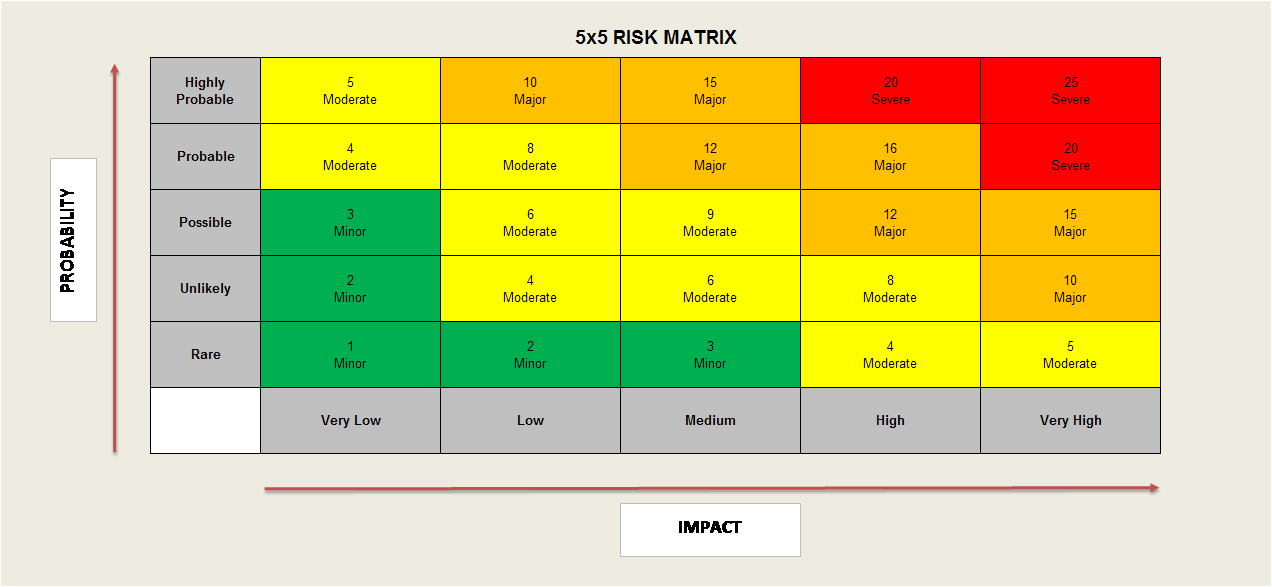
| Risk event | Explanation | Probability | Impact | Score |
|---|---|---|---|---|
| Lacking knowledge and experience | Since An, Triet and Nghia were not familiar with these concepts, it took us at least 1 week to familiarize ourselves with the basic concepts. Fortunately, Phuong is an expert in this field, and being aware of the situation of Phuong's group gave us a way to familiarize ourselves with the new knowledge to avoid difficulties. For example, An would focus on learning how to make a login page, and Nghia and Triet will study a lot about CSS to create a beautiful interface. | Probable | Low | 8 - Moderate |
| Privacy and Security | Since our website will handle personal and sensitive donor information, there is a risk of data breaches or unauthorized access. We must implement robust security measures, including encryption, secure data storage, and regular security audits, to protect the privacy of our donors and maintain their trust in our platform. | Possible | Very High | 15 - Major |
| Scale | As the website gains popularity and user traffic increases, there is a risk of server overload and downtime. We must design and deploy the website on a reliable hosting infrastructure that can handle high volumes of traffic. Regular monitoring and proactive scalability measures will be crucial to ensure uninterrupted access for donors and stakeholders. | Unlikely | High | 8 - Moderate |
| Technical | Integrating various technologies and platforms, such as Google Maps, and databases carries the risk of unexpected issues. We need to ensure seamless integration and data exchange between different components of the website, minimizing any potential disruptions or data inconsistencies. | Possible | Medium | 9 - Moderate |
| Regulatory Compliance | As a platform dealing with medical data, we must comply with relevant healthcare regulations, such as data privacy laws (e.g., GDPR, HIPAA). Failure to adhere to these regulations could lead to legal consequences and damage the reputation of our project.. | Unlikely | Very High | 10 - Moderate |
3.2.8 Group process and commnications
- Communication methodologies:
Over the period of working on this donation website project, our team has set up various channels of communication in order to improve work efficiency and handle misadventures that might come up during our time working together. In using various modes of communication, our team can juggle between formal project discussions to informal idea exchanges.
- Meeting and Formal Discussion: To communicate difficult and technical topics of the project, our team often conducts face-to-face or online meetings to discuss with each other about how we should approach these subjects. First we determine the agenda of the meeting, this is to make sure that the meetings are productive through knowing the type of questions that need to be addressed to all team members, by following the listed agendas, we can make sure to make the most of our hour during the meeting. And to accommodate the meeting, our team would work out everyone's schedule and select a timeframe where all members are available to meet at the university campus. However, we were only able to arrange a handful of face-to-face meetings before moving everything online in the later weeks of this assignment. This is due to the increase in study load for our team in other subjects, thus, by arranging online calls via Microsoft Teams, our available time slot to set up meetings expands significantly. The team usually engages in up to 3 meetings per week, and during the discussion, we would address the pending tasks that need to be finished and resolve new issues that come up as we do our work.
- Daily Report and Common Exchange: Regarding the mentioned informal exchange, we use Facebook Messenger where a group chat has been created to become the common ground of information messaging. To regulate what everyone can discuss, we have set up some rules to maintain the quality of flow of information in the group chat, these consists of:
- Only group work discussion only: This rule limits the type of topics allowed to be discussed in the group chat, it exists to prevent the group chat from becoming overloaded with messages unrelated to the project or our current study courses. There is some leeway for everyone to discuss topics outside of school work, however, we all try to keep it to an acceptable level.
- Semi-daily progress report: All team members are required to update their progress on the currently assigned task on a semi-daily basis. This rule exists to keep everyone on track with their job and also to provide transparency to the team work. Notably, We decided not to make it a daily chore because all of our team members often handle multiple responsibilities and we do not want to overwork them with too many mandatory daily reports.
- Workspace Management:
To manage the artefacts of this project, our team uses Google Drive (https://drive.google.com/drive/folders/1pB2t25a5QbCOtxCdoovIJNlJmdFNXbPD?usp=sharing) and GitHub to manage our research documents and programming files. On Google Drive, similar to what we have done in Assignment 2 - The IT World, separate folders were set up to categorise our documents, such as research notes, report drafts and final format. While GitHub is the platform that we use to administer our coding work, everyone on our team uses Visual Code Studio for programming on our own computer, but the finished work is always submitted and updated onto GitHub. By integrating these productivity platforms to our project, we can further improve the accessibility and transparency of teamwork. Another useful tool that our team plans to utilise is Trello, where it will be a managing platform for the timeline of this project; when this platform is applied appropriately, it can help us delegate tasks and keep track of each team member’s work progress.
- Team Processes and Dynamics:
Acknowledging the great many technical demands of this project, RedBytes expects to encounter many new problems and misadventures, thus, we have also laid down some basic protocols to handle unexpected issues. In the case where two of our team members, Nghia and Triet, who have caught the Covid-19 and was bedridden for quite some time, our team make sure to readjust the assigned tasks to available members while handing simpler tasks to the sick member when they are ready to work again, as this was done to ensure the timeliness of progress. Regular weekly meetings were still a mandatory routine for our team, however, there are times when not all members are available to join the discussion. In which case, they are required to inform the rest of the team at least a day before the meeting so that the team leader can decide to postpone or proceed with the meeting. Should a meeting be initiated without the presence of all members, we made sure to keep a summarised list of completed and pending issues to help the absent member catch up with the team’s current development. Over the course of working together on this subject, our team was fortunate to not have any major argument between members, but in the prospective case of undesirable altercations, our team hoped to deal with the matter in a peaceful and respectful manner. The plan would be to listen to both sides of the argument where everyone will try to find the middle ground where both parties are satisfied, our team intends to take the issue to higher authorities such as our lecturer or course coordinator.
IV. Skills and Jobs
As mentioned in the project limitation, our website has postponed the data analysis and visualisation functions for later due to our insufficient experience and knowledge. However, in the case where this web project is given the opportunity for investment and further development, the next step of expansion would be to include an API integration for data analysis. This development stage will be much more technical compared to the work that we have done so far, therefore, the team will need to hire qualified personnel to aid in the formal development process. Some of the features that the project should complete in this development plan are to design a data collection and scraping process, build a data processing architecture, integrate analysis modules to the system, testing and revision, etc. Forecasting a six-month development period for the mentioned features, we hope to assemble a team of professionals from specific specialties to handle the major technicalities required for the advanced features. This would be a team of four, of which consists of a project manager, a data analysis, a back-end developer and a quality tester.
Project manager: As the complexity level of the project grows in the upcoming development stages, it would be a correct decision to have a project manager overseeing the further developments. This position will be the first recruitment decision for the project, as having a project manager on board will introduce a higher level of professionalism and work proficiency to the team via their expertise in regulating the team resource and keep progress moving on schedule. By definition, a project manager is responsible for organising and monitoring a project as well as making sure results are completed within scope and delivered on time without going over the allotted budget (Nieto-Rodriguez & Khelifi 2021). For our project, they will be acting as a leader for the new team of four that will be carrying out the new development in a period of six months. They are expected to be handling the planning phase which includes identifying the key stakeholders who will be affected by the new features and understanding the implementation objectives to design high-level scopes, deadlines, risks, etc. And during the execution stages, the project manager should be overseeing the progress and maintaining a positive progressive environment for the team members to help everyone successfully complete their assigned tasks. Thus, the project manager that we hope to recruit should be able to demonstrate the necessary skills required for their position, of which are (PMI 2023): Leadership and Effective Communication: a project manager must have the ability to pilot and communicate with their team and also stakeholders effectively. Planning and Time Management: to efficiently delegate tasks to suitable personals and to ensure project artefacts are delivered on time. Adaptability and Innovative Problem Solving: a project manager must be able to solve and adapt to obstacles and arising issues to ensure timely progress and quick recovery from losses. Motivation and Team Management: to ensure high morality for team members while they work on the project, to solve any problem that might arise within the team’s dynamic and to guarantee quality results.
Data Analyst: As discussed earlier in our goals for the Loving Donor project, we hope to integrate data study into the blood donation process to find useful insights that can improve blood donation, storage and transportation processes. To be more specific, we want to discover the hidden patterns in data that may enable us to make informative decisions to prevent unfortunate events such as blood bank shortage. Our team requires the skills of a data analyst because, aside from the data calculation that they can provide, they have the ability to combine both the study result with the data to provide comprehensible illustrations for our users and stakeholders. The reason for this decision is rooted in our goal to provide the best user experience for our donors so by having to actually see how their donation could positively impact the bigger interest of the public and also for medical institutions to forecast future scenarios where a scarcity in donated blood might occur. A data analyst in our team will bear the responsibility of collecting, structuring and interpreting data to find the insight for a hypothesis that they formulate based on the request of users and stakeholders (Gagnon 2022). Therefore, aside from having the ability to work with data and be familiar with the various data analysis tools such as R, Python, SQL, they also need to be able to interpret and communicate their findings with everyone (Coursera 2023).
Back-end Developer: As of the submission date of this report, the current development stage of our website has only been limited to the front-end construction. Therefore, to further the completion of our project, our team would need to hire a back-end developer to handle the databases, create APIs and set up our servers. The back-end developer on our team will be working on tasks such as (Deshpande 2023): Developing and maintaining APIs and systems. Finalising and securing databases. Optimising application for performance and scalability. Write programs and create test suites for quality assurance. For them to be able to complete these tasks, our team will be looking for a back-end developer that has a quality background in computer science and web design; they must be familiar with AWS technology development and also be able to create secure applications. And finally, they must be resourceful with their job, being flexible with the assigned tasks and able to work through obstacles using their creativity (SII 2023).
Quality Assurance Tester: Through recruiting a tester, we will be able to ensure the usability and quality level of our website before releasing it to the public. As our team does not have sufficient experience and knowledge in creating a professional product, having a tester in our team will make up for our inexperience as they will have to follow a formal procedure to test every possibility of the product and generate a comprehensive report on the quality of the website for revision and correction. The quality assurance tester is essential for our website to reach the proper functioning level before launch as they will evaluate the current system and new implementation to look for any possible problems and help improve the overall user experience of our website (Burns 2019). For our website, the tester is expected to review and implement a systematic testing procedure with a structure consisting of the following tasks (Indeed 2023): Design test suites for various circumstances. Document and evaluate results. Identify and report bugs and glitches. Detect and isolate errors and failures. Review user interfaces and feedback. For this project, we want to hire a quality assurance tester that is proficient in testing software, knowledgeable with programming languages to handle to technical testing aspects; they should also have a keen sense of attention to details and have good analytical skills to be able to examine the testing results; and finally they should also have a decent degree in soft skills to able to communicate with the rest of the team.
V. Group Reflections
Nghia Pham - s3974975
After working with the group, I myself have learned many things and understood more about the members. I believe one of the things we do well is communication. This is one of those rare times when it comes to teamwork, it's a disagreement of opinion, our team respects each other's opinions and when we decide on an issue, we accept it. as well as improve and make it the best. Besides, our team has reasonable working time, which leads to quite effective work performance. However, there are bound to be limitations, I believe one of them is time management. From the beginning, most people wanted to get it done as soon as possible, but when we realized that the deadline had come, we didn't meet the deadline the team set itself. Even so, I firmly believe that this is a good point as it is quite easy to improve. The fact that there was no internal quarrel was quite a surprise for me, but the most surprising thing was that 2 out of 4 members of the group were infected with Covid-19. But despite the limitations on health, the team can still manage and do well in the work they undertake. This has really given me a lot of experience in handling unexpected situations, besides, I believe I have learned a lot about presentation skills, especially the synchronization between speech and actions leading to the delivery of the highest quality content.
An Tran - s3959931
Although I am not an experienced or the oldest member, I have been assigned the role of project manager and developer. Initially, I was surprised by the opportunity to become a project manager. It is indeed a challenging role, but with my own efforts and the support I received, I find this job interesting and meaningful. I started my work by understanding the strengths and weaknesses of each team member through conversations. I always strive to create a dynamic and positive environment where team members are not restricted and can leverage their strengths. As a project manager, I always provide clear task assignments and deadlines for each team member, aiming to ensure that goals are completed on time and not to delay the group's progress. However, I have been too strict in controlling the project, which has made people feel demotivated when working with me. The climax was when two out of four members fell ill during the project. I was shocked when I heard the news, but after calming down, I realized that I should not put too much work pressure on everyone. It would be better if I could balance the work and personal lives of the team members. Additionally, I am also responsible for the development website as a developer. I was extremely surprised that Phuong, despite being a first-year student, had a solid foundation in website design, helping me familiarize myself with new concepts like frontend (FE), backend (BE), and user interface/user experience (UI/UX). After working with the team for a while, I learned that it can be very beneficial to let team members shine in their respective fields. On the other hand, a strict leadership style can sometimes limit creativity and performance. Most importantly, the team becomes strongest when members support and help each other, working together to grow and develop.
Triet Dang - s4022878
To be able to participate and work on this assignment has been a very valuable learning experience for myself, to be more specific, I was to gain a great deal of knowledge in website development and IT market insights. Over the period of this assignment, we have encountered numerous obstacles such as myself and another team member getting sick because we contracted the Covid-19 virus and busy schedules. But our team was able to overcome these challenges, thanks to An, who took up the role as the project manager, with his ability to quickly respond to sudden development to formulate the appropriate response. However, from my perspective, I believe that there is one shortcoming that we should address which is the project and planning stage. It is likely due to the fact that our team is relatively new to the formal procedure of producing a functioning website so there were some hiccups when it came to the execution process. So for future endeavors, I firmly believe that the correct decision on how we should approach a new and difficult project is to do extensive research on how we should work as a team to tackle the technical aspects of a job. In this project, I was fondly surprised that our team has a very good dynamic when working with each other: everyone accommodates each other's needs, there are rarely any arguments and, if there arise opposing ideas, we always try to find the middle ground that all team members are satisfied with. In the course of working on this assignment with my team, one of the more valuable lessons that I was able to learn was that everyone must play to their strength in order for the group to be successful. As our team leader, An, who was very considerate of everyone, delegated work to us according to our strength and affinity with the task. So even with the mishaps that we have faced along the way, our team was still able to make it out on top of the most challenging situation.
Phuong Tran - s3979638
Firstly, it was great to say that expectations for team collaboration were met, with responsible and efficient work under time pressure. We communicated effectively and supported each other throughout the project. However, there is still room for improvement. Some members struggled to work on their own and be independent, though this was a minor issue as we continuously reminded and pushed others to do good work. I hope implementing a stricter policy on deadlines and also punishments could address this. Additionally, it took time for some members to familiarize themselves with the required tools like HTML, CSS, and GitHub, so we wish to have better guidance and materials that would streamline the development process better. Surprisingly, specific tasks took longer than expected, directly affecting our timelines and introducing conflicts to external events and other ongoing assignments. Recognizing this, I'll start accounting for potential delays for future projects. This group experience also taught me the importance of recognizing and leveraging individual strengths. Triet's data analysis expertise, An's responsible leadership, and Nghia's hardworking nature were valuable contributions. To sum up, our team has done well considering the pressure and the high expectation of the project. Addressing issues with deadlines, planning for unexpected delays, and providing better documentation and guidance for the basics will help us improve in the long run. On top of that, recognizing and utilizing individual strengths is vital to success.
Group Reflection
Overall, throughout the 12 weeks of studying the Essentials of Information Technology course, our team of four members—An, Phuong, Nghia, and Triet—had the opportunity to interact and work effectively together. Initially, we thought that working as a team would be challenging since none of us knew each other before, but we were pleasantly surprised to find that the process went smoothly and all team members collaborated exceptionally well. It can be said that each member was dedicated and enthusiastic about both the group work and the assigned tasks.
Our first group assignment arrived early, and since we had limited experience in project execution, each member would read the assignment requirements first and then meet to discuss and determine the project's direction, along with specific responsibilities for each individual. But, this became our working process for the next assignment, with a few changes from online meetings on platforms like messaging apps, and Google Meet, and ultimately decided to conduct our meetings on Teams due to its superior features and the ability to store meeting information. Each member's tasks also changed throughout the assessments, where An initially took on the role of Project Manager, responsible for managing the completion process and deadlines, followed by Phuong as the Technical Leader in order to assist An's role. While each member held a different position and had distinct responsibilities, we always strived to provide feedback and review each other's work. This not only improved the quality of our assignments but also strengthened our bond as a team.
In terms of document storage, we utilized Google Drive and Google Docs, while code was done on Visual Studio Code and GitHub. As for communication, we used Facebook Messenger and Team online meeting room as a means of contact. The aforementioned tools undoubtedly contributed significantly to the convenience and effectiveness of group work. Although it cannot be denied that working as a team could be challenging at times, especially when Triet and Nghia faced a fever during tight deadlines, our team always showed understanding and supported each other through simple encouraging questions. As a result, our motivation and team spirit remained high throughout the entire process.

Overall, even though we only collaborated for the duration of one course, our team highly valued one another. We all learned that a group assignment could be challenging, but with each individual's opinions and efforts, we could overcome any obstacles. We believe that a team progresses further when each member respects and supports one another, enabling personal development every day.
VI. Appendix
VII. References
- Burns C (2019) QA Tester Job Description Template, Comeet website, accessed 18 May 2023. https://www.comeet.com/resources/job-descriptions/qa-tester#:~:text=Quality%20assurance%20(QA)%20testers%20play,and%20other%20user%20experience%20issues.
- Coursera (2023) What Does a Data Analyst Do? Your 2023 Career Guide, Coursera website, accessed 18 May 2023. https://www.coursera.org/articles/what-does-a-data-analyst-do-a-career-guide
- Deshpande C (2023) What is Backend Development? Skill, Salary, Roles & More, Simplilearn website, accessed 18 May 2023. https://www.simplilearn.com/tutorials/programming-tutorial/what-is-backend-development
- Gagnon D (2022) What Does a Data Analyst Do?, SNHU (Southern New Hampshire University) website, accessed 17 May 2023. https://www.snhu.edu/about-us
- Indeed (2023) How To Become a Quality Assurance Tester, Indeed website, accessed 18 May 2023. https://www.indeed.com/career-advice/career-development/how-to-become-a-qa-tester
- International Trade Administration (2023) Vietnam - Country Commercial Guide, International Trade Admission website, accessed 17 May 2023. https://www.trade.gov/country-commercial-guides/vietnam-healthcare#:~:text=Much%20of%20the%20existing%20medical,facilities%2C%20equipment%2C%20and%20services.
- New Zealand Blood Service (2023) Become a donor, New Zealand Blood Service website, accessed 16 May 2023. https://www.nzblood.co.nz/
- NHS Blood Donation (2023) Give Blood - Do something amazing, NHS website, accessed 16 May 2023. https://www.blood.co.uk
- Nieto-Rodriguez A and Khelifi Y (2021) Is Project Management the Right Career for You?, Harvard Business Review website, accessed 17 May 2023. https://hbr.org/2021/12/is-project-management-the-right-career-for-you
- PMI (Project Management Institute) (2023) Who are Project Managers and What Do They Do?, PMI website, accessed 17 May 2023. https://www.pmi.org/about/learn-about-pmi/who-are-project-managers#
- PMI (Project Management Institute) (2023) Who are Project Managers and What Do They Do?, PMI website, accessed 17 May 2023. https://www.pmi.org/about/learn-about-pmi/who-are-project-managers#
- SANBS (South African National Blood Service) (2023) Visit your nearest donation site to donate, SANBS website, accessed 16 May 2023. https://sanbs.org.za
- SII (Sokanu Interactive Inc) (2023) What is a Back-End Developer?, Career Explorer website, accessed 18 May 2023. https://www.careerexplorer.com/careers/back-end-developer/
- Vietnamplus (7 April 2022) ‘Voluntary blood donation a popular movement in Vietnam', Vietnamplus, accessed 15 May 2023. https://en.vietnamplus.vn/voluntary-blood-donation-a-popular-movement-in-vietnam/224689.vnp
